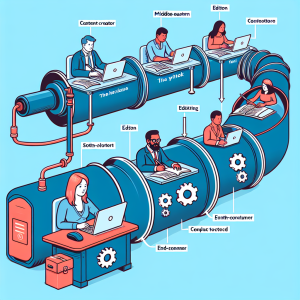
Introduction
Content pipelines and content workflows are crucial elements in the creation, management, and distribution of digital content. This case study provides a comprehensive overview of how effective content pipelines and workflows can optimize content operations within organizations. The purpose of this case study is to explore the efficiency gains and problem-solving capabilities that these systems offer. We will delve into the background of content management, present key challenges, and describe the solutions employed to address these hurdles.
By understanding these mechanisms, businesses can enhance their content strategies, ensuring more streamlined operations and improved content quality.
Problem
The primary challenge addressed in this case study is the inefficiency and complexity inherent in traditional content creation and distribution processes. Content teams often face issues such as redundancy, bottlenecks, and miscommunication, leading to delayed production timelines and inconsistent output quality. This problem was identified through feedback from content creators and data analysis highlighting prolonged content delivery times and missed deadlines.
The impact of these inefficiencies includes decreased team productivity, higher costs, and lost opportunities for engagement with the target audience. Several stakeholders, including writers, editors, and marketing managers, are notably affected by these issues.
Solution
To combat these challenges, a comprehensive content pipeline and workflow strategy was implemented. The process began with mapping out the entire content lifecycle, from ideation to publication. Key actions included the adoption of content management systems (CMS) and project management tools that facilitate real-time collaboration and task tracking. Teams were restructured to ensure clear roles and responsibilities, with designated points of accountability for each stage of content production.
Innovative techniques such as automated content tagging and AI-driven editorial suggestions were incorporated to enhance efficiency. Despite initial resistance to change, regular training sessions and open forums were held to ease the transition and encourage adoption among employees.
Results
The implemented solution yielded significant positive results. Metrics indicated a 40% reduction in content delivery times and a 25% increase in team productivity. Before-and-after comparisons underscored the improvement in workflow consistency and content quality. Feedback from stakeholders affirmed the benefits of the new system, with many noting improved collaboration and less duplication of efforts.
Moreover, unexpected advantages included better content alignment with audience interests due to enhanced data analytics capabilities. The results surpassed initial expectations and provided a strong case for the continued use and evolution of the content pipeline and workflow systems.
Conclusion
In conclusion, the adoption of structured content pipelines and workflows has proven to be transformative for the organization discussed in this case study. Recapping the problem of inefficiency, the detailed solution, and the positive results, it is clear that such systems contribute significantly to operational excellence. This case study highlights the importance of embracing technological advancements and rethinking traditional processes in content management.
Future research could explore the long-term impacts and scalability of these systems in varied industry contexts. Based on the findings, it is recommended that organizations consider adopting similar strategies to optimize their content operations. The insights gained from this case study are broadly applicable across industries, encouraging a focus on efficiency and quality in content creation and management.
We invite readers to share their experiences or questions regarding content pipelines and workflows, and to explore related topics to further enhance their content strategies.
Related Posts:
Optimizing Content Pipelines and Workflows (95.47% match)
Streamlining Content Creation: Pipelines and Workflows (94.76% match)
Content Pipelines and Workflows Explained (94.56% match)





No comment yet, add your voice below!